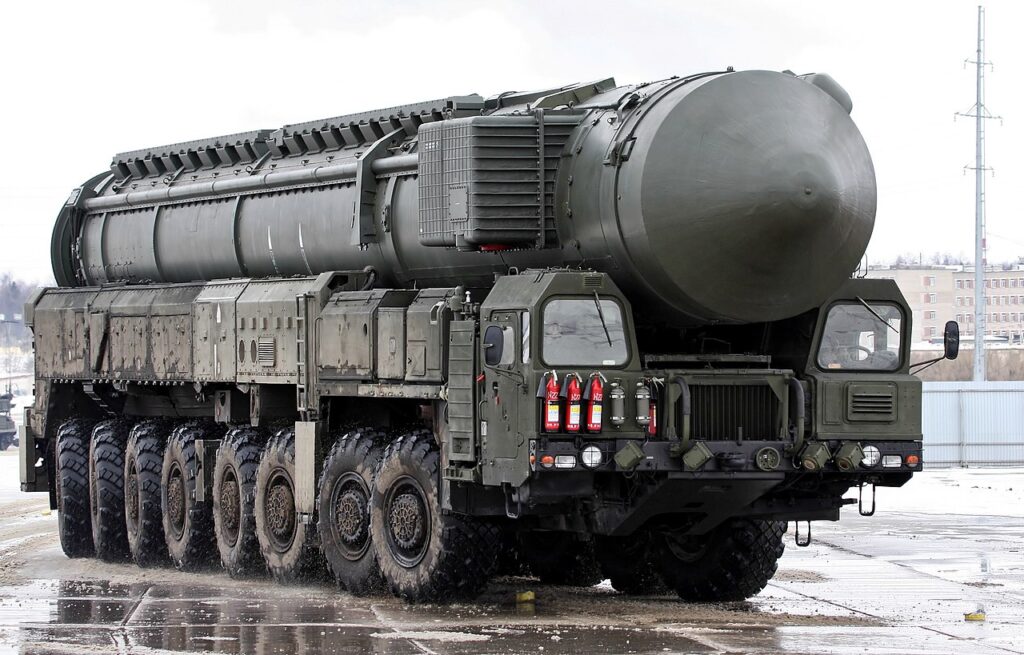
Photo: Vitaly V. Kuzmin/CC BY-SA 4.0
What is Oreshnik Missile?
First publicly acknowledged by President Vladimir Putin in late 2024, the Oreshnik represents Russia’s newest intermediate-range ballistic missile (IRBM) system. This advanced weapon system showcases Moscow’s continued investment in high-speed, long-range strike capabilities and reflects evolving strategic priorities in Russian military doctrine.
Technical Specifications
- Classification: Intermediate-Range Ballistic Missile (IRBM)
- Maximum Speed: Estimated at Mach 10+ during terminal phase
- Operational Range: 3,000–5,500 km (dependent on payload)
- Warhead Options: Multiple independently targetable reentry vehicles (MIRVs) with nuclear or conventional payloads
- Guidance Systems: Combined inertial navigation with suspected GLONASS satellite updates
Comparative Capabilities
The Oreshnik fills a critical gap in Russia’s missile hierarchy between tactical and strategic systems:
| System | Type | Range | Warhead | Role |
|---|---|---|---|---|
| Oreshnik | IRBM | 3,000–5,500 km | MIRV (nuclear/conventional) | Theater strike / strategic deterrence |
| Iskander-M | SRBM | 500 km | Single/conventional | Tactical strikes |
| Avangard | HGV | 6,000+ km | Nuclear | Strategic penetration |
Key advantage: The Oreshnik’s intermediate range allows strikes on European targets without triggering ICBM response protocols.
Defense Implications
NATO’s existing missile defense architecture faces new challenges:
- Interception Complexity: Mach 10+ terminal velocity exceeds the engagement envelope of most current interceptors.
- Discrimination Difficulty: MIRV deployment requires advanced radar tracking to distinguish warheads from decoys.
- Early Warning Gap: Potential use of depressed trajectories could reduce radar detection time by 30–40%.
Upcoming solutions like the Glide Phase Interceptor (GPI) and European Sky Shield initiative aim to address these vulnerabilities by 2026–2028.
Development and Initial Deployment
Based on technical analysis, the Oreshnik appears derived from the RS-26 Rubezh platform. Its first confirmed operational use occurred in November 2024 against a strategic target near Dnipro, Ukraine. This deployment demonstrated the system’s multi-warhead capability, representing a significant evolution in Russian ballistic missile technology.
Geopolitical Reach of Oreshnik Missile
The missile’s maximum range places numerous strategic locations within striking distance:
- All NATO territory in Eastern and Central Europe
- U.S. military installations throughout Europe
- Key Middle Eastern partner nations
- Strategic locations across Central Asia
Strategic Consequences
Western defense experts have identified several concerning implications:
- Deterrence Calculations: Requires reassessment of NATO’s eastern flank protection strategies
- Arms Control: Complicates existing and future missile limitation agreements
- Regional Stability: Potential deployment in Belarus could alter regional power dynamics
Final Thoughts on Oreshnik
The Oreshnik’s combination of high-speed ballistic capability, adaptable payloads, and intermediate range establishes it as one of Russia’s most strategically significant missile systems. As deployment numbers increase, this weapon will likely play a central role in:
- Russian strategic force posture
- NATO defense planning considerations
- Global nonproliferation discussions





